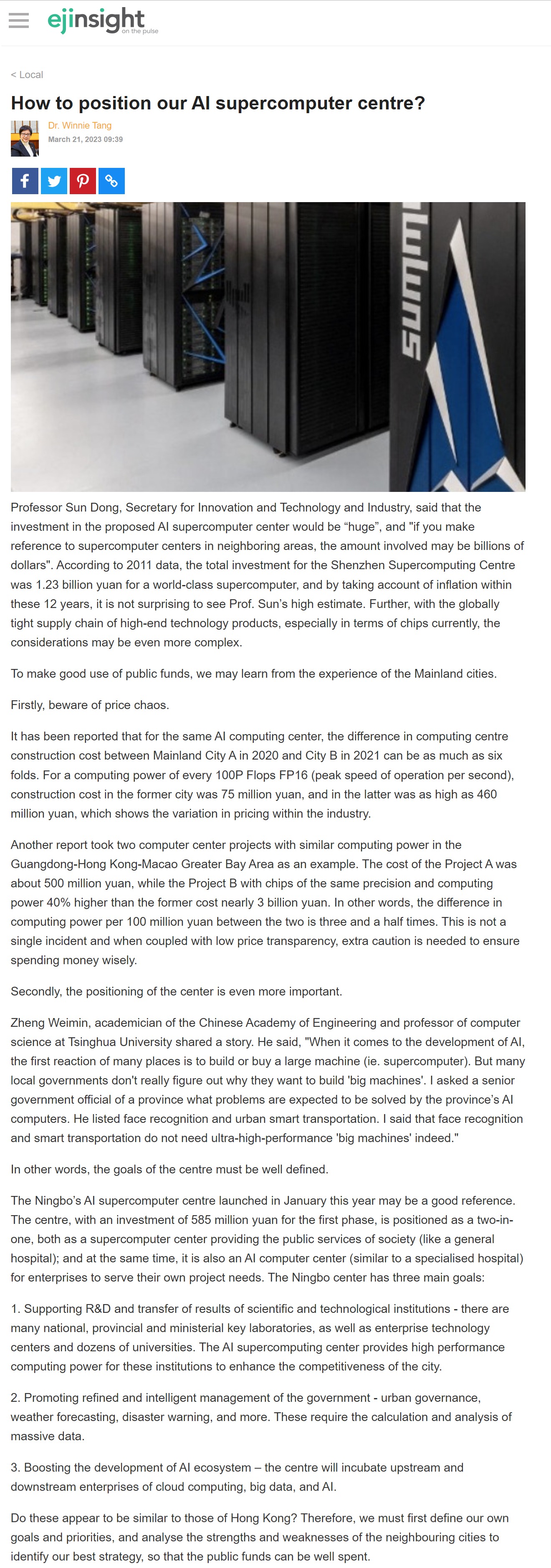網上版請按此

How to position our AI supercomputer centre?
Professor Sun Dong, Secretary for Innovation and Technology and Industry, said that the investment in the proposed AI supercomputer center would be "huge", and "if you make reference to supercomputer centers in neighboring areas, the amount involved may be billions of dollars". According to 2011 data, the total investment for the Shenzhen Supercomputing Centre was 1.23 billion yuan for a world-class supercomputer, and by taking account of inflation within these 12 years, it is not surprising to see Prof. Sun's high estimate. Further, with the globally tight supply chain of high-end technology products, especially in terms of chips currently, the considerations may be even more complex.
To make good use of public funds, we may learn from the experience of the Mainland cities.
Firstly, beware of price chaos.
It has been reported that for the same AI computing center, the difference in computing centre construction cost between Mainland City A in 2020 and City B in 2021 can be as much as six folds. For a computing power of every 100P Flops FP16 (peak speed of operation per second), construction cost in the former city was 75 million yuan, and in the latter was as high as 460 million yuan, which shows the variation in pricing within the industry.
Another report took two computer center projects with similar computing power in the Guangdong-Hong Kong-Macao Greater Bay Area as an example. The cost of the Project A was about 500 million yuan, while the Project B with chips of the same precision and computing power 40% higher than the former cost nearly 3 billion yuan. In other words, the difference in computing power per 100 million yuan between the two is three and a half times. This is not a single incident and when coupled with low price transparency, extra caution is needed to ensure spending money wisely.
Secondly, the positioning of the center is even more important.
Zheng Weimin, academician of the Chinese Academy of Engineering and professor of computer science at Tsinghua University shared a story. He said, "When it comes to the development of AI, the first reaction of many places is to build or buy a large machine (ie. supercomputer). But many local governments don't really figure out why they want to build 'big machines'. I asked a senior government official of a province what problems are expected to be solved by the province's AI computers. He listed face recognition and urban smart transportation. I said that face recognition and smart transportation do not need ultra-high-performance 'big machines' indeed."
In other words, the goals of the centre must be well defined.
The Ningbo's AI supercomputer centre launched in January this year may be a good reference. The centre, with an investment of 585 million yuan for the first phase, is positioned as a two-in-one, both as a supercomputer center providing the public services of society (like a general hospital); and at the same time, it is also an AI computer center (similar to a specialised hospital) for enterprises to serve their own project needs. The Ningbo center has three main goals:
1. Supporting R&D and transfer of results of scientific and technological institutions - there are many national, provincial and ministerial key laboratories, as well as enterprise technology centers and dozens of universities. The AI supercomputing center provides high performance computing power for these institutions to enhance the competitiveness of the city.
2. Promoting refined and intelligent management of the government - urban governance, weather forecasting, disaster warning, and more. These require the calculation and analysis of massive data.
3. Boosting the development of AI ecosystem – the centre will incubate upstream and downstream enterprises of cloud computing, big data, and AI.
Do these appear to be similar to those of Hong Kong? Therefore, we must first define our own goals and priorities, and analyse the strengths and weaknesses of the neighbouring cities to identify our best strategy, so that the public funds can be well spent.
Dr. Winnie Tang
Adjunct Professor, Department of Computer Science, Faculty of Engineering; Department of Geography, Faculty of Social Sciences; and Faculty of Architecture, The University of Hong Kong